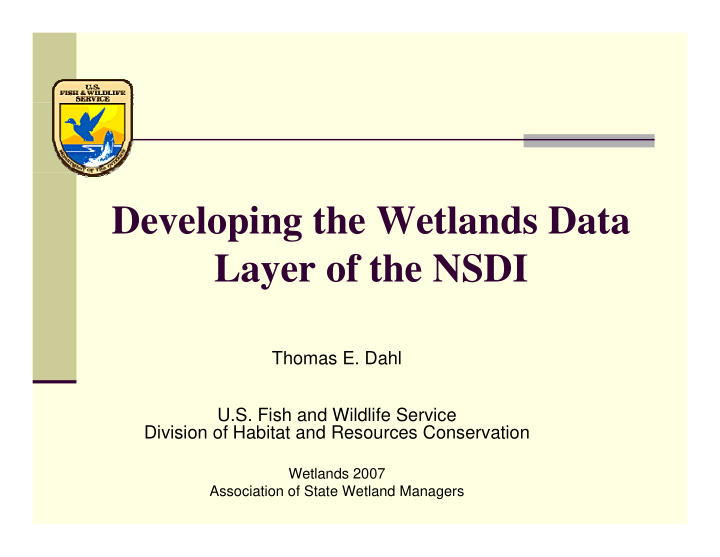



Developing the Wetlands Data Layer of the NSDI Thomas E. Dahl U.S. Fish and Wildlife Service Division of Habitat and Resources Conservation Wetlands 2007 Association of State Wetland Managers
National Spatial Data Infrastructure National Spatial Data Infrastructure The National Spatial Data Infrastructure (NSDI) was envisioned as a way of enhancing the y g accessibility, communication, and use of geospatial data to support a wide variety of decisions at all levels of society (The National d i i t ll l l f i t (Th N ti l Research Council 1993).
Wetlands Data Layer Wetlands Data Layer Under the Office of Management and Budget Circular A 16 revised August 19 2002 Circular A-16, revised August 19, 2002, responsibility to coordinate wetlands data related activities is assigned to the Department of related activities is assigned to the Department of Interior, U.S. Fish and Wildlife Service.
Wetlands Data Collection Wetlands Data Collection FWS has maintained a wetlands mapping pp g effort for 30 years – National Wetlands Inventory FWS wetland definition is the FGDC standard FWS data form the framework for wetlands spatial data spatial data Not all in digital format Dates range 1980s to present
http://www.fws.gov/wetlands/
FWS Wetlands Data - Status FWS Wetlands Data Status The Wetlands dataset is designed to integrate digital map data with other resource resource information to produce timely and relevant relevant management and decision support tools.
FWS Wetland Data - Status FWS Wetland Data Status Over 30,000 maps in seamless ArcSDE Over 30,000 maps in seamless ArcSDE (17 million features, 45 Gigabytes) 58 % of lower 48, 20% of Alaska, 100% Hawaii Standardized Format map data in a single standard projection (Albers Equal-Area Conic Projection) E l A C i P j ti ) horizontal planar units in meters horizontal planar datum – NAD ‘83 horizontal planar datum NAD 83 Data Internet available Wetlands Mapper; “The National Map” (WMS, OGC, GOS) p ( , , )
Wetlands Geodatabase Info Wetlands Geodatabase Info. http://wetlandsfws.er.usgs.gov/index.html http://wetlandsfws.er.usgs.gov/index.html
Defining Data Layer Characteristics Defining Data Layer Characteristics National in scope Contemporary – technology and content Metadata compliant (FGDC) Easily expanded and updated Consistent, standardized format Temporal versions - historic data Integrate related geospatial data themes I l d i l d h Riparian data Coastal barriers Coastal barriers
Contemporary Data – technology and content Ab About 3.5 % of data mapped from source materials t 3 5 % f d t d f t i l 10 years old or less FWS updates about 1 – 2 % per year Database increasing in size annually primarily due to Database increasing in size annually primarily due to existing data being converted to digits More/newer data will have to come from other sources
Completion of Wetlands Layer Completion of Wetlands Layer Lead federal agencies develop and g p implement a plan for completion of each data theme (OMB) FWS Plan will use a tiered approach Incorporation of existing data in various formats Incorporation of existing data in various formats Contributed data Cooperator assistance Plan must be strategic
Potential Raster Image Files g
Contributed Data Contributed Data NSDI planning incorporates contributed data Contributed data are vital to maintaining a viable data layer Contributed wetland data… Contributors anxious to provide data Mapping Standards lend to this effort
Additional Data Contributors Additional Data Contributors
Benefits of Participation Benefits of Participation Recognition of your organization’s data as a g y g source of geospatial information Common use of your data by resource managers Justification for resources to maintain data Access to the most comprehensive geospatial A t th t h i ti l data inventory at no cost Access to companion Web-based resource Access to companion, Web-based resource data HGM – type descriptors Wetland Restorations
Contributed Data Implications Contributed Data - Implications Challenges in tracking a quilt-work of data (metadata) Data handling, verification coordination D t h dli ifi ti di ti with data producers Retain data integrity and security Retain data integrity and security Develop cross-walks where needed Acknowledge contributors A k l d t ib t Data stewardship
Implications > Data Considerations Implications > Data Considerations FWS Standards/FGDC Standards Information Quality Guidelines OMB Peer Review Requirements Sound Science Initiative Geospatial Line of Business DOI Enterprise Architecture DOI IT Security Program FWS Database Security Plan
Summary Wetlands NSDI Summary - Wetlands NSDI FWS is actively developing the Wetlands Layer of NSDI - preparing plan to complete the data layer by NSDI i l t l t th d t l b 2010 Challenges in tracking a quilt-work of data Follow NSDI model to collaborate and coordinate with data producers -- Actively seeking data contributions http://www fws gov/wetlands/ http://www.fws.gov/wetlands/
Recommend
More recommend